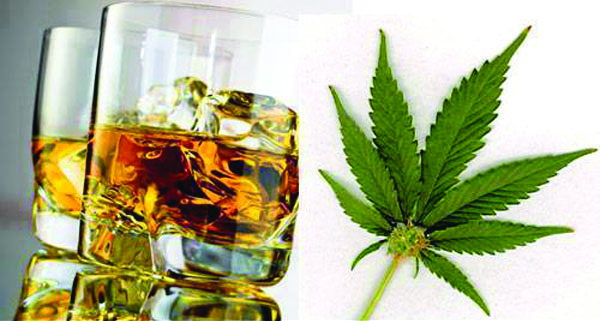The debate over whether alcohol or cannabis is safer to consume has been the topic of many discussions in the medical and political worlds. There is a large amount of evidence about the health benefits and deficits for both substances, and here I will compare the two.
The short-term effects of alcohol are plentiful: impaired motor coordination, altered decision-making, depressant effects, nausea and vomiting, and the possibility of alcohol poisoning resulting in death. Driving under the influence of alcohol can result in death of not only the driver but also their passengers and others. Long-term effects include alcoholism, cirrhosis of the liver, and increased risk of cancer in the liver, esophagus and mouth, pharynx and larynx. Alcohol is currently the most easily accessible drug in the United States, and the most socially acceptable. Recent studies have also shown that alcohol is the #1 gateway drug, a title that had been previously assigned to cannabis. The only recognized health benefit from alcohol is the presence of antioxidants in red wine, which when consumed in moderation is thought to decrease the risk of heart disease.
The short-term effects of cannabis can also be negative. Impaired motor coordination, increased heart rate, feelings of paranoia, drowsiness and memory loss are all possible side effects of cannabis consumption. Long-term health deficits have yet to be identified, but cannabis has been shown to affect the developing brain. However, cannabis is non-toxic and it is impossible to overdose. The associated health benefits of cannabis also far outweigh the negative effects. Decreased anxiety and depression, relief from nausea and vomiting, and pain relief are just a few of its many capabilities. Cannabis is also far less likely than alcohol to interact with other drugs. States that have legalized cannabis are undergoing the growing pains of keeping cannabis out of the hands of minors, particularly with products like edibles; however, despite how common cannabis is, it is still harder to access than alcohol.
One major difference in the relative safety of these two substances is their regulation. While alcohol is regulated at a national level, most cannabis on both the legal and black markets would be the equivalent of bathtub moonshine. Standards for cannabis production and even for the labs testing their products are still being determined, and this leaves a wide disparity in quality and potency of products. The effects of alcohol consumption may hold a higher risk, but you know that a Coors Light purchased in California will affect you the same way as one bought in Florida. The current illegal status of cannabis will prevent it from being a safe, regulated recreational alternative to alcohol.

